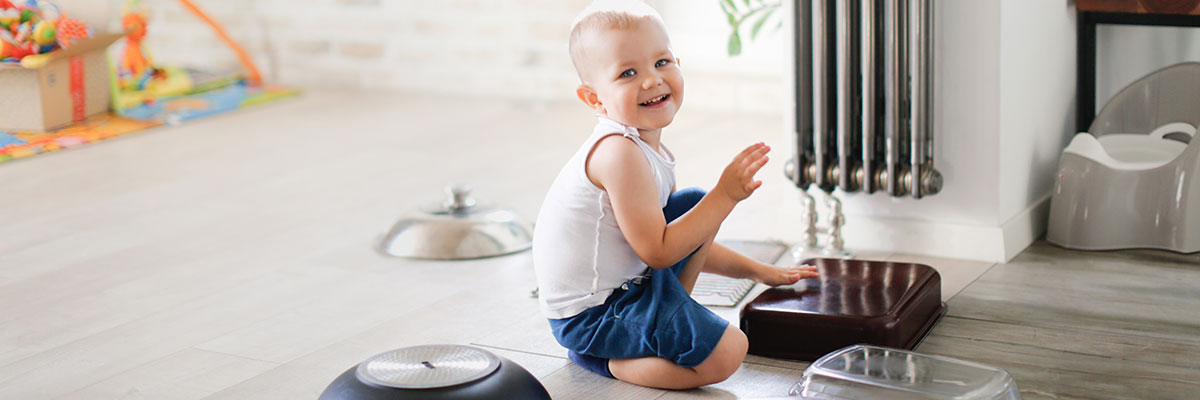
Article at a Glance
With a bit of assistance, your one-year-old just got done ripping open her birthday presents. You bought her all the highly recommended, kid-approved, educational toys, yet, she seems more interested in the wrapping paper and the box.
You’re not alone—in fact, a lot of kids are perfectly content with wadding up and tossing wrapping paper or wearing a box as a hat. As new parents, our wallets may sting, but it’s best to embrace and encourage play that improves motor, sensory, and communication skills. So, instead of looking to retailers for the most educational baby and toddler toys, try transforming household items into toys.
Newborns as early as 2 months can recognize faces and are drawn to high-contrast colors and patterns. Consider making a homemade mobile that lets you clip on a series of different objects and mix in photos of family members. As with all mobiles, be sure to keep it well out of reach.
At this age, your baby is starting to reach and pull for nearby toys. To help develop this skill, take an old tissue box and stuff some fabric or handkerchiefs of different colors and textures and let your baby pull them out.
Babies typically start rolling over and tracking moving objects with their eyes between 3-6 months. Many start to push up on their arms and a few even attempt to crawl. You can encourage these skills with those stress balls you got from the office party. Let your child push, poke, and track the stress balls during tummy time to develop core strength and coordination.
In addition to squishy toys, a mirror secured at ground level is another way to keep a baby entertained while on his or her tummy. And finally, saving a special rattle or teething toy for tummy time exclusively is another way to prolong your child’s interest in this skill-building time.
Fill empty water bottles with macaroni noodles, beads, or coins to create a baby rattle. Rattles are fun and noisy, and they help your baby develop grasping and sensory skills. Make sure that the lid is sealed tight (or even super-glued) to avoid choking hazards.
Around 6-9 months is when your infant may begin to switch things from hand to hand and sit up unassisted. Spread out dishware like spatulas, plastic spoons, plastic cups, and lightweight bowls to let them explore the different shapes and sizes from their high chair or seated on the floor.
This is a great opportunity to encourage your child to switch objects from hand to hand and also build their verbal skills by talking with them about each item they have.
Babies love to look at themselves in the mirror. A handheld safety mirror makes a fun toy that helps improve eye tracking and hand coordination. Try placing or holding the mirror in different places to help improve range of motion.
Before tossing the empty oatmeal container, try giving your child some wooden spoons and letting him have fun drumming a beat. If you’re up for a little more noise, you can even use pots and pans. This helps build their hand-eye coordination and arm strength. It also helps mom and dad train for the noise and chaos that lays ahead in the toddler years.
One of the biggest milestones at this age is when kids start to pull themselves up to a standing position and can walk supported or sometimes unsupported. Make it fun and safe for them by making a couch cushion obstacle course. They’re likely to stumble a bit and the cushions can soften the fall. You can even add music to the adventure and let your child dance midway through the course.
As your child starts to recognize size and shapes more, they learn the art of stacking and ordering objects. Spread out the measuring cups or plastic cups and let them develop their organizational skills. At this age, kids can also follow simple instructions. So, when they’re done stacking, you can direct your child to help put the cups away.
If you have a silverware organizer, you can empty it out and have your child organize the flatware. At this age, kids can recognize familiar objects, so having them organize silverware helps with memory and communication skills. Obviously, make sure your child is seated and that you’ve placed the steak knives and corn skewers somewhere else.
Depending on your child’s dexterity, sorting small foods (berries, cereals, cut soft veggies, etc.) into the cavities of a muffin tin can be another way to encourage motor skills and get a reluctant eater to taste new foods. This is a great time to count his or her objects aloud as they sort.
Now that your little one is starting to run, climb, and explore, turn off the lights and hand them a flashlight to look for things around the house. You can either have them bring the things back to you or have her point them out. This not only helps them develop their motor skills and memory of where things are, but it can also be a help to kids who are afraid of the dark.
Using yarn, dried pasta noodles, big beads, or cut up toilet paper rolls, your toddler can practice their fine motor skills by looping the string through the cavities to make necklaces and toys. At this age your child can also start to make marks with crayons and washable markers, so he or she can decorate their creations too.
Just as life’s most valuable lessons aren’t taught inside a classroom, our children’s developmental milestones aren’t reached with the newest super-toy.
NOTE: Whatever toys you make with household items, be sure to supervise your child to prevent injury. Avoid using household objects that can be cut, may shatter, be swallowed, or stuffed up a tiny nostril. Stay safe and have fun!

As a pediatrician and father of six kids, Dr. Bartholomew has a lot of experience with twins and premature infants. In addition to getting to know his patient families, he enjoys the great outdoors, Dr. Seuss, and BYU football.